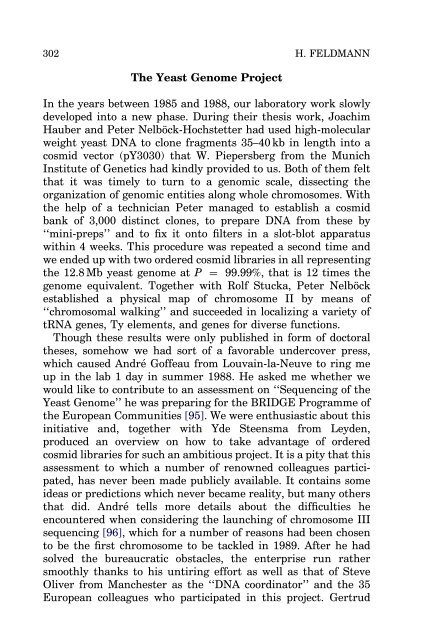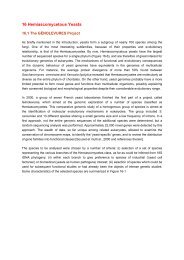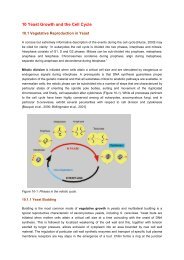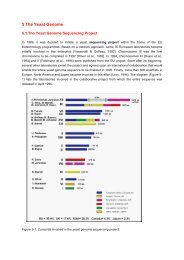A Life with Yeast Molecular Biology - Prof. Dr. Horst Feldmann
A Life with Yeast Molecular Biology - Prof. Dr. Horst Feldmann
A Life with Yeast Molecular Biology - Prof. Dr. Horst Feldmann
You also want an ePaper? Increase the reach of your titles
YUMPU automatically turns print PDFs into web optimized ePapers that Google loves.
302<br />
The <strong>Yeast</strong> Genome Project<br />
H. FELDMANN<br />
In the years between 1985 and 1988, our laboratory work slowly<br />
developed into a new phase. During their thesis work, Joachim<br />
Hauber and Peter Nelböck-Hochstetter had used high-molecular<br />
weight yeast DNA to clone fragments 35–40 kb in length into a<br />
cosmid vector (pY3030) that W. Piepersberg from the Munich<br />
Institute of Genetics had kindly provided to us. Both of them felt<br />
that it was timely to turn to a genomic scale, dissecting the<br />
organization of genomic entities along whole chromosomes. With<br />
the help of a technician Peter managed to establish a cosmid<br />
bank of 3,000 distinct clones, to prepare DNA from these by<br />
‘‘mini-preps’’ and to fix it onto filters in a slot-blot apparatus<br />
<strong>with</strong>in 4 weeks. This procedure was repeated a second time and<br />
we ended up <strong>with</strong> two ordered cosmid libraries in all representing<br />
the 12.8 Mb yeast genome at P ¼ 99.99%, that is 12 times the<br />
genome equivalent. Together <strong>with</strong> Rolf Stucka, Peter Nelböck<br />
established a physical map of chromosome II by means of<br />
‘‘chromosomal walking’’ and succeeded in localizing a variety of<br />
tRNA genes, Ty elements, and genes for diverse functions.<br />
Though these results were only published in form of doctoral<br />
theses, somehow we had sort of a favorable undercover press,<br />
which caused André Goffeau from Louvain-la-Neuve to ring me<br />
up in the lab 1 day in summer 1988. He asked me whether we<br />
would like to contribute to an assessment on ‘‘Sequencing of the<br />
<strong>Yeast</strong> Genome’’ he was preparing for the BRIDGE Programme of<br />
the European Communities [95]. We were enthusiastic about this<br />
initiative and, together <strong>with</strong> Yde Steensma from Leyden,<br />
produced an overview on how to take advantage of ordered<br />
cosmid libraries for such an ambitious project. It is a pity that this<br />
assessment to which a number of renowned colleagues participated,<br />
has never been made publicly available. It contains some<br />
ideas or predictions which never became reality, but many others<br />
that did. André tells more details about the difficulties he<br />
encountered when considering the launching of chromosome III<br />
sequencing [96], which for a number of reasons had been chosen<br />
to be the first chromosome to be tackled in 1989. After he had<br />
solved the bureaucratic obstacles, the enterprise run rather<br />
smoothly thanks to his untiring effort as well as that of Steve<br />
Oliver from Manchester as the ‘‘DNA coordinator’’ and the 35<br />
European colleagues who participated in this project. Gertrud







